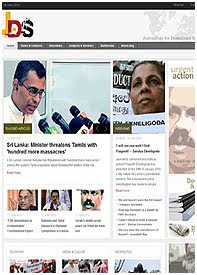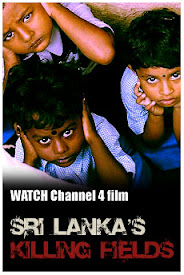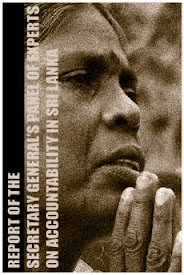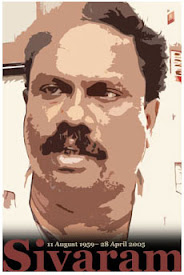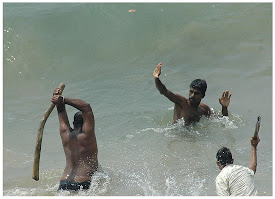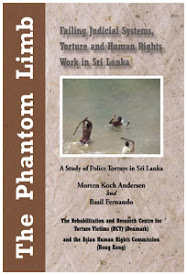
By Michael Richardson | The Japan Times
.............................................................................................................................................................................................
China's involvement has inevitably raised speculation that Hambantota is the latest jewel in a so-called string of pearls that will pave the way for China's rapidly expanding navy to operate routinely in the Indian Ocean from secure bases in the region.
The aim would be to challenge U.S. and Indian naval dominance in the area and ensure that China itself could protect vital trade and energy supply lines instead of having to rely on potentially hostile powers. Already, China imports over half the oil it needs and at least 75 percent is shipped across the Indian Ocean from the Persian Gulf and Africa. Moreover, China's dependence on imported oil needed to run its modern land, sea and air transport is rising.
If direct protection of Chinese trade routes and other interests in the Indian Ocean is indeed the objective of those in China supporting development of a blue water fleet able to project power over long distances, there is still a great deal of work to be done before the "string of pearls" becomes a network of naval and air bases remotely comparable to those India already has on its mainland and on its islands in the Andaman Sea guarding the western approaches to the Malacca Strait, or even to the joint U.S.-British base on Diego Garcia atoll in the mid-Indian Ocean.
If China has ambitions to become an Indian Ocean military power, it is doing so by stealth, starting with commercial operations. Sri Lanka's official website says the first phase of Hambantota's development now being completed cost about $360 million, with 85 percent of the funding from the Chinese government and the remaining 15 percent from the Sri Lankan government.
Unlike Sri Lanka's main port in the capital, Colombo, on the western flank of the island, and Trincomalee, a natural deep-water harbor on the northeast coast, Hambantota is located very close to a key junction of the main international shipping lanes linking Europe, Africa and the Middle East to Asia via the Straits of Malacca and Singapore.
About 70,000 seagoing merchant vessels, from giant oil tankers to container ships and other cargo carriers, round the southern tip of Sri Lanka each year. Hambantota is hoping to induce some of these ships to refuel, replenish and trans-ship cargo to places like India, Myanmar and the Maldives through the new port and its associated facilities, taking business away from established regional maritime hubs, particularly Singapore, which is the world's busiest port and offers a wide range of maritime services.
The Hambantota project is being built in four stages at an estimated cost of $1.5 billion. By the time work finishes in 2014, Hambantota will be able to handle 33 ships at a time. It will have extensive bunkering, cargo handling, storage, warehouse and trans-shipment capacity. It will also have ship-building and ship-repair yards, as well as a nearby industrial zone and airport. But it will still be small in comparison to major Asian ports such as Singapore, Hong Kong and those in Japan, China and South Korea.
Still, some Indian analysts say that access to the harbor and airport will enable China to support its naval deployments in the region more effectively. However, the head of the Sri Lanka Ports Authority said earlier this month that China would have no role in operating Hambantota, although it had provided a loan and two Chinese construction companies, China Harbor Engineering Company and Sinhydro Corporation, were helping in the port construction.
China has made similar loans to develop commercial port facilities at Gwadar, in Pakistan not far from the entrance to the Persian Gulf, and Chittagong in Bangladesh. Neither has yet yielded much commercial benefit, let alone assured naval access, for China.
There are signs that Beijing is now seeking to do in the Indian Ocean what the U.S. military has done in Southeast Asia since the 1990s — establish a network of "places not bases" by negotiating country-by-country agreements allowing naval ships and, in some cases military aircraft as well as service personnel, to use base facilities that remain under the control of the host government.
This approach avoids sensitivities about foreign bases violating national sovereignty. Applied in the Indian Ocean, it could help China avoid inflaming its already complicated relations with India, while still supporting Chinese naval operations.
Since China started sending its navy on anti-piracy patrols in the Gulf of Aden and off the Horn of Africa in late 2008 to protect Chinese merchant vessels, its warships have called mainly at Salalah, in southern Oman, and to a lesser extent in Aden, Djibouti and Karachi, to refuel, replenish and allow crews to take shore leave.
It may only be a matter of time before these port calls are upgraded to a series of formal agreements guaranteeing access and support for Chinese naval ships. Writing in the Jamestown China Brief last month (July), Daniel Kostecka, a senior China analyst with the U.S. Department of the Navy, said that such agreements might be negotiated for ports of particular importance to the Chinese navy's missions and presence in the Indian Ocean, such as Salalah, Aden and possibly Karachi, where there are ship-repair yards and the Chinese Navy has close ties with the Pakistan Navy.
However, it seems highly unlikely that the commercial port facilities China has helped to build at Hambantota and Gwadar will be converted into bases for the Chinese Navy. Aside from the sovereignty issue, the costs of conversion to full-fledged military use would require billions of dollars in Chinese investment. Even then, they would be vulnerable to attack from highly accurate long-range missiles in a crisis.
Michael Richardson is a visiting senior research fellow at the Institute of South East Asian Studies in Singapore.
© The Japan Times
Thursday, August 19, 2010
Hambantota: Another 'pearl' in Beijing's string of ports
Thursday, August 19, 2010
Among the Tamils of Toronto, a tense wait for news
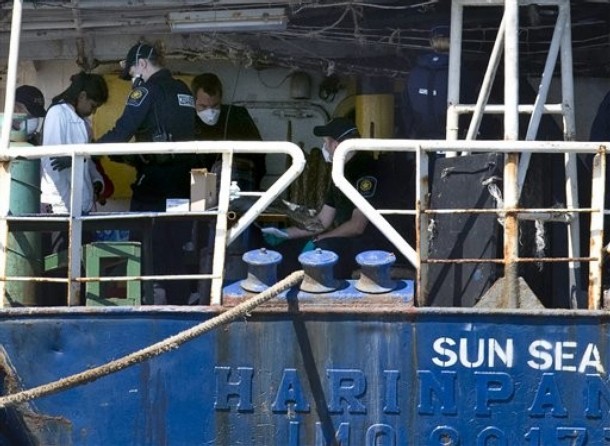
By Joe Friesen | The Globe and Mail
.............................................................................................................................................................................................
Two men sit across from him, their arms folded, worry written across their faces. One has come direct from his job at the fish market after being tracked down by the Tamil Refugee Co-ordinating Committee. He has been told a nephew was among the 492 refugee claimants from the MV Sun Sea who are being held in detention in British Columbia. His nephew had memorized his phone number and provided it to a lawyer.
The man says he had no idea his nephew was on board the ship. He hasn’t seen him for six years, since he was still a teenager in school. The last he heard from the boy’s mother was that they were in a camp for people displaced by the Sri Lankan civil war, which ended in May, 2009. Now he’ll have to find a way to contact her to let her know her son has made it to Canada safely, having been reassured by Mr. Sinnarasa that Canada is not going to put the migrants back on the ship.
This man’s story ends happily, Mr. Sinnarasa explains, but not all do.
“One came because they said a particular person left Malaysia in a small boat, but unfortunately I checked and that person is not on the ship,” Mr. Sinnarasa said. “So they now presume the boat must have broken up or sank off Malaysia.”
There are dozens of similar stories of people approaching refugee lawyers and Tamil community leaders hoping that relatives not heard from in months might be among the 492. Many are not.
Mr. Sinnarasa spoke by telephone to the mother of the man who died on the voyage of an unknown illness and was buried at sea.
“She is in a terrible state,” he said. “The aunt told me this man was beaten by the army some time back and that’s why he was trying to escape. He has a three- or five-year-old child and wife.”
Ravi Sri sits next to a pile of about 30 boxes filled with clothes and toiletries that Toronto’s Tamil community, more than 200,000 strong, has collected for the migrants. He has just been told that a close relative and her family are among the refugee claimants. He hasn’t seen her in 25 years, but had been sending her money in Thailand after she fled Sri Lanka as a refugee.
“She didn’t tell me anything,” he said. “I would have told her not to take such a risk, crossing the ocean in a little cargo ship.”
He said his relatives had been harassed by government paramilitaries and were told by the United Nations refugee workers that their safety could not be guaranteed. They gave up everything – their farm and business – to flee with their children.
As other volunteers circulate around him, handling calls, fielding donations and organizing files, Mr. Sinnarasa sits calmly at the centre of the room. Above him on the wall of this small, low-ceilinged unit in a Scarborough industrial park is a poster of Article 14 of the Universal Declaration of Human Rights: Everyone has the right to seek asylum in other countries from persecution, the poster reads.
Mr. Sinnarasa insists he asks very few questions of the migrants’ families, or whether anyone is paying the fee of $40,000 that the government claims is being funnelled to the Tamil Tigers.
“I’m not very inquisitive. I’m trying to tell them the situation. Tell them they’re here so they can have some peace of mind,” he said.
© The Globe and Mail
Thursday, August 19, 2010
Operation Pacific Angel : US - Sri Lanka militaries repair a school

Photo courtesy: Master Sgt. Mike Hammond | US Air Force
By Master Sgt. Mike Hammond | Pacific Angel 10-4 Public Affairs
.............................................................................................................................................................................................
The engineers dug trenches, laid water lines to the outdoor restroom facilities, and built classrooms at the Semandaluma Kanishta Vidyalaya school. As the mission continues, the team will also paint the buildings, repair and upgrade a shower facility, and install water faucets -- among other tasks. The project in Puttalam is one of two Engineering Civic Assistance Programs being conducted as part of the U.S. Pacific Command-led Pacific Angel-Sri Lanka. Another combined team of U.S. and Sri Lankan engineers is simultaneously working on the Mahasiyabalagaskada Vidyalaya school in Neriyakulam Township.
In addition to offering needed repairs, the program is meant to foster teamwork between the partnering nations' governmental, civic, and military forces.
"This is my first experience working with foreigners, and I'm enjoying it," said Sri Lankan Army Cpl. Agith Priyantha GK, a nearly 20-year veteran with the 4th Civil Engineer Regiment. "The Americans have the proper equipment and technology for the task. Their speed of work and the combination with our people is good."
For 13-year old Amali Shashikala, an 8th grader at Semandaluma Kanishta Vidyalaya school, the Pacific Angel program will have a tremendous impact.
"After this renovations program, it will be a good environment to study in," said Amali, whose favorite subject is English. "The other students feel the same way. I am very happy because this is the first time anyone has come out to make improvements to our school," she said, adding that she hopes to one day become a teacher at the school. "I want to make a contribution and share my knowledge with society."
According to Ranjaney Fernando, the principal of the school, resources have been hard to come by until this mission. She has been principal since 2000, and the school teaches grades 1-9. "The people are very poor, and we do not have enough teachers," she said. "The teachers we do have, come from different areas. Three teachers actually live in the school. We make many sacrifices to educate the children. With the lack of resources and the climate here, it is a difficult environment for education. Because of this (Pacific Angel) program, our infrastructure will improve."
Operation Pacific Angel is a U.S. Pacific Command-led Medical and Engineering Civic Assistance Program. It seeks to build partnerships among various nations in the Pacific and South Asia regions. Pacific Angel-Sri Lanka, in addition to the civil engineering work, is also accomplishing medical treatment and training with Sri Lankan, Maldives, and Mongolian counterparts. The exercise continues this week and is scheduled to conclude Aug. 22.
© US Pacific Command
Thursday, August 19, 2010
Majority of Sri Lankan Tamil refugees reluctant to go back to Sri Lanka

By R.K. Radhakrishnan | The Hindu
.............................................................................................................................................................................................
Talking to TheHindu here on Wednesday on the sidelines of a national seminar on ‘Refugee situation in India today,' he said that many of the refugees had become part of the local community and some even married locals. They had taken up jobs as masons or carpenters.
The government was providing them all facilities available to voters in the State, including subsidised rice and other material. Even free television sets were given to them (20,039 sets have already been distributed). As many as 52,373 individual identity cards had been issued to refugees aged above 12 years to ensure their welfare and security.
Enrolment of refugees in schools and colleges had gone up compared to the previous year. In 2008-09, the total number of students enrolled in schools and colleges was 21,023. In 2009-10, this rose to 21,742. But the nursery level enrolment dropped from 3452 (2008-09) to 3076 in 2009-10.
A Rs.55-crore housing scheme would be implemented for their benefit. The Rural Development Department would be in charge of the scheme. Land identification process was on. Chief Minister M. Karunanidhi had written to the Centre asking it to consider conferring citizenship on refugees who had lived here for long.
In all, the Rehabilitation department had spent Rs.74.56 crore in 2009-10 on the welfare of Tamil refugees (excluding the Rs.100 crore announced by the Chief Minister for infrastructure development in camps) as against Rs.0.21 crore spent in 1983-84 (before the influx of Sri Lankan Tamils). However, some of the refugees wanted to go back because of the limited job prospects here, he said.
The seminar was organised by the United Nations High Commissioner for Refugees and the Centre for Asia Studies.
There are 70,325 persons (20,251 families) staying in camps, besides 32,365 persons (11,933 families) staying as non-camp refugees in the State. There are 112 camps across 25 districts and two special camps. While a special camp at Ramanathapuram (Mandapam) houses 2,837 persons, the one at Tiruchi (Kottapattu) has 1,559 persons.
Of the total Sri Lankan refugees who arrived in India since early eighties, (3.03 lakh from July 24, 1983 to July 21, 2010), about one lakh refugees were sent back in two phases (1987-89 and 1992-95). Another one lakh had left India for Sri Lanka or third countries on their own with valid travel documents.
The refugees who were willing to go back to Sri Lanka or to any other country of their choice at their own cost were issued “exit permits” by Collectors. Up to 2010 May, a total of 7041 persons, who were interviewed by the United Nations High Commissioner for Refugees and signed the returnee forms had been sent back voluntarily to Sri Lanka with the assistance of the UNHCR. Of this, 687 persons, belonging to 215 families left India this year.
© The Hindu
Thursday, August 19, 2010
Chinese Inroads Into Sri Lanka

By B. Raman | Outlook India
.............................................................................................................................................................................................
*At the same time, the Government of India has a duty to take note of the various aspects of the relations, which could be detrimental to our national security and evolve an appropriate policy response.
* The policy response could be either actively countering their influence in Sri Lanka or actively promoting our interests in Sri Lanka or a mix of both.
* Another response could be in the form of a mix of incentives and disincentives -- incentives to make it worthwhile for Sri Lanka to have closer relations with India than with China or Pakistan and disincentives if it is insensitive to India’s concerns and interests.
* A good incentive could be by making the huge Indian market easily accessible to the goods and services of Sri Lanka, by making it worthwhile for Sri Lankan students to study in India, by sharing our IT expertise with Sri Lanka, by encouraging networking between the corporate worlds of the two countries etc
* A strong disincentive could be by using our traditional pressure points in Sri Lanka such as the dependence of Sri Lanka’s tourism economy on Indian tourists, the goodwill for India in large sections of SL society etc
* Unfortunately, we are yet to work out a comprehensive and workable policy response.
* We are worried over the increasing Chinese influence and its implications for India’s security, but we do not articulate our concerns. We pretend as if Indian and Chinese interests will never clash in Sri Lanka and we try to give an impression that we can take it in our stride.
* Our policy response, if at all there is any, is ad hoc and not strategic with the immediate and long-term interests influencing the response.
* China’s policy, on the other hand, caters to its interests of today as well as its likely interests of tomorrow and the day after. There is nothing ad hoc about it.
* China is not a South Asian power, but has acquired a robust South Asian presence through its carefully-cultivated relations with Pakistan, Sri Lanka, the Maldives, Bangladesh and Nepal.
* China is not an Indian Ocean power, but it is seeking to acquire a robust Indian Ocean presence through its relations with Myanmar, Bangladesh, Sri Lanka, Maldives, Mauritius & Seychelles.
* India is a South Asian and Indian Ocean power, but its South Asian and Indian Ocean influence is being eroded by the increasing inroads of China at the expense of India.
* This presentation will focus essentially on China and not on Pakistan. The threat to us from Pakistan through Sri Lanka is more tactical than strategic, more subversive than military, more political than economic. China is a dragon, but Pakistan is still only a pinprick.
* We should be alert to the possibility of China and Pakistan acting in tandem in Sri Lanka and the Maldives to undermine the Indian influence, but there is as yet no evidence of this possibility becoming a reality, but it could in the long-term.Our policy response should nip this bud before it starts blooming.Beyond this caution, I will not say anything else on Pakistan in this presentation.
General Observations & Quotes
* Under President Mahinda Rajapaksa, Chinese presence and influence in Sri Lanka have increased.He has visited China thrice since assuming office. Increase in bilateral interactions and exchange of visits.Sri Lanka opened a consulate—its second one in China—in Chengdu, where Pakistan already has an active Consulate. The Chengdu Military Region coordinates China’s military strategy in South Asia.
* “China and Sri Lanka are long standing friends. China never deserted Sri Lanka in its times of distress”--Rajapaksa in April 2008 while inaugurating the construction of Sri Lanka’s National Theatre of Performing Arts to be built with Chinese assistance.
* “The friendly relationship between the two countries has stood long test and the two countries are tested friends. Sri Lanka has always firmly stood by and will never change its stance on one-China policy”—Rajapaksa on September 4,2009, while receiving a delegation of the Chinese Communist Party.
* “The Chinese Government endeavours to develop its friendship and cooperation with Sri Lanka on the basis of the Five Principles of Peaceful Co-Existence. Chinese enterprises are contracted to build the Hambantota port. Any vicious distortion of the normal business deal holds no water. Social stability, economic development and ethnic reconciliation of Sir Lanka serve the shared aspiration and fundamental interest of the Sri Lankan people. We sincerely hope this goal can be achieved at an early date” --.Chinese Foreign Ministry Spokesperson Ma Zhaoxu at his regular press conference on May 12, 2009.
* “Sri Lanka’s traditional donors, namely, the United States, Canada and the European Union, had receded into a very distant corner to be replaced by countries in the East. The new donors are neighbours; they are rich; and they conduct themselves differently. Asians don’t go around teaching each other how to behave.There are ways we deal with each other — perhaps a quiet chat, but not wagging the finger. Chinese assistance has grown fivefold in the last year to nearly $1 billion, eclipsing Sri Lanka’s long-time biggest donor, Japan” -- Palitha Kohona, Sri Lankan Foreign Secretary as quoted by the New York Times dated March 9, 2008
Bilateral Trade
* Trade between the two countries has doubled over the last 5 years from US$ 660 million to US$ 1.13 billion, making China the second largest exporter to Sri Lanka and the 13th largest export destination for Sri Lanka’s exports.
"We have paid far too much attention to the export markets in the US and now we need to move towards the Asian giant China. We have had an over dependence in the US market for our exports for too long," Prof. A. D. V. De S. Indraratna, President, Sri Lanka Economic Association.
* Sri Lanka exports coconut fiber products, natural rubber, tea, spices, precious and semi-precious stones and ready made garments to China. There has been a significant increase of Sri Lankan exports to China since 2000, mainly due to the bulky export of mineral sands as zicronium ores , coir fiber and electrical components etc. The exports of mineral sands rose from Rs. 10 million in 2001 to Rs. 226 million in 2008. Only 0.45 per cent of Sri Lanka’s total exports go to China, but 12 per cent of its total imports come from China.
Project Assistance—Hambantota Port
* The foundation for the construction of a modern port with Chinese assistance at Hambantota in southern Sri Lanka was formally laid in October,2007. The construction actually started in January,2008.
* It is a 15-year project to be completed in stages. The entire project is estimated to cost US $ one billion. The present Chinese commitment is for the construction of the first stage only, which is estimated to cost US $ 360 million. China has agreed to give 85 per cent of this amount at concessional interest. The balance is being contributed by the Government of Sri Lanka.
* The first stage of the 15-year (2008-2023) project is expected to be completed by the end of 2010. This stage envisages the construction of a 1000-metre jetty, which will enable the harbour to function as an industrial port for the import and export of industrial chemicals, fuel and heavy machinery. By 2023, Hambantota is projected to have a liquefied natural gas refinery, aviation fuel storage facilities, three separate docks giving the port a transshipment capacity and dry docks for ship repair and construction. The project also envisages that when completed the port will serve as a base for bunkering and refuelling.
* The draught (depth) of the new harbour will be 16 metres against 15 metres in Colombo. A 230 metre passage-entrance channel will be created at the breakwater which is 988 metres long on the west end and 311 metres long on the east end.
* The Government hopes that as a refueling location Hambantota will have many advantages over the Colombo port or ports in South India. The construction has been undertaken by a consortium of Chinese companies headed by the China Harbour Engineering Company and the Sino Hydro Corporation.
* The project doesn’t have a separate consultant. The Sri Lanka Port Authority (SLPA) is functioning as the client-cum-consultant while the China Harbour Engineering Co Ltd is the contractor. In September,2008,there were 328 Sri Lankans and 235 Chinese working at the site-engineers, administrative personnel and others. The present number is not known.
* The first stage due to be ready by end 2010 will allow three ships to berth. The final stage, for which there is no offer of funding yet from China, is planned to accommodate more than 30 ships, which is the present capacity at Colombo.
* Reliable reports say that while the Sri Lankan authorities want Hambantota to emerge as a modern port with better facilities and efficiency than any of the ports in South India, they do not want the present importance of the Colombo port to be reduced. Colombo presently has the reputation of being the most modern and most efficient port in South Asia. They want this reputation to be maintained. There is no proposal at present to set up container yards and cater to container ships at Hambantota.
* The present Chinese interest is in the use of the docking and refueling facilities that would come up in Hambantota for their commercial and naval ships. There is no proposal at present for a Chinese naval base at Hambantota.
New Container Terminal at Colombo
* Chinese port operator China Merchants Holdings (International) is negotiating with the Sri Lankan authorities a contract for the construction of a new container terminal at Colombo. The company has bid for the contract jointly with a Sri Lankan company Aitken Spence.
Maththala Airport--Hambantota
* On November 27,2009, Rajapaksa inaugurated the construction of Sri Lanka's second international airport at Maththala in Hambantota.
The new airport will be constructed on a plot of 2,000 hectares in Hambantota district at a cost of US$ 190 million. The Government of the People's Republic of China will provide financial assistance for the project with a soft loan through its Ex-Im Bank.. According to the Ports and Aviation Ministry, the construction of the airport will be completed in two phases. All basic facilities including runways, taxiways and parking facilities will be completed in the first phase to be completed by 2011. All other airport and aviation related facilities will be completed in the second phase. These include servicing and repairing centre for aircraft, hotels, pilot training centre, maintenance hub, private jet parking, and technical training centers. The Government hopes to commission the airport by the end of 2011 and land the first flight by December 2011.
Other Projects with Chinese Assistance
* The construction of the Colombo--Katunayake Expressway.( US $ 248 million)
* Improvement of the railways--US $ 100 million to be given by China’s Ex-Im Bank. Agreement signed on March 10,2010.
* Norochcholai Coal Power Plant (US$855 million)
* A flood protection system for Colombo suburbs of Kotte, Dehiwela-Mount Lavinia, Maharagama, Kesbewa and Moratuwa. ( US $ 59 million) To be given by China Construction Bank.
* National Theatre of Performing Arts in Colombo ( US $ 21 million)
* Sri Lanka's investment promotion agency, the Board of Investment, announced in July,2009, it has signed a deal with China's Huichen Investment to manage a special economic zone dedicated to Chinese investors. Huichen will invest US $28 million in the zone in Mirigama, north of Colombo, to improve infrastructure in the first phase over three years.The company, a conglomerate that specialises in infrastructure development and does coal and iron ore mining, will also market the zone and attract Chinese investors.
* More than 50 per cent of the funding received by Sri Lanka from abroad for construction and development projects since Rajapaksa came to power came from China.
* "Since 2007, Sri Lanka has been trying to launch a communication satellite. China has agreed to provide financial and technical assistance," Executive Director of the Institute of Policy Studies, Dr. Saman Kelegama was quoted as saying in November 2009. In May 2009, Priyantha Kariyapperuma, Director-General of the Telecommunications Regulatory Commission, had said that the Government had begun work on a space programme hoping to launch two communication satellites.
* "The University of Surrey specializes in satellite technology having created about 35 satellites. They have made a presentation to President Mahinda Rajapakse and have entered into an agreement to transfer technology and knowledge to our universities," he told the Island Financial Review. Kariyapperuma said a consortium of vice chancellors from universities with engineering faculties had been formed for this purpose. He said the Government planned to launch two communication satellites—a lower earth orbit satellite used mainly for images and a geo stationary communication satellite. The two satellites will be used not only for communication purposes but also for disaster management, agriculture planning, irrigation planning, town/urban planning and coastal conservation. He said the low earth orbiting satellite could be financed with domestic funds particularly from the Telecommunication Development Fund. The private sector would also be called to contribute to the development of the two satellites.
Chinese Project Assistance—Some Features
* All except a thermal power plant in Sinhalese majority areas.
* The Chinese have agreed to consider project proposals from the Tamil areas in future, including a proposal for improvement of road communications in the Jaffna peninsula.
Projects of Concern from India’s security point of view
* Hambantota Port: Though at present there is no talk of a naval base, it could emerge ultimately to cater to the requirements of Chinese oil & gas tankers and anti-piracy patrols.
* Communications satellite with Chinese assistance could be used for the collection of TECHINT about India’s nuclear and space establishments in South India.
Other Chinese Assistance
* One million U.S. dollars in humanitarian aid to help internally displaced persons.
* Technical assistance for demining operations in the Northern and Eastern Provinces .
* China’s humanitarian assistance is meagre. Its assistance focuses on areas which could benefit its strategic goals.
Chinese Military Equipment Supplied for Use Against LTTE
* Jian-7 fighter jets, anti-aircraft guns and JY-11 3D air surveillance radars .Average military supplies to Sri Lanka estimated at US $ 100 million per annum.
Exploration of Oil & Gas
The policy of the Rajapaksa Government is whatever benefit is offered to India, an equal benefit will be offered to China. It offered one block each without bids in the Gulf of Mannar area to India and China for exploration.
India’s Response
* No public articulation of Indian concerns.
* It is not known whether there has been any private articulation through diplomatic channels and, if so, how strong & effective.
* With the SL Government having subdued the Tamils with Indian, Chinese and Pakistani assistance, India no longer has this pressure point in Sri Lanka.
* Economic pressure may still work because of the large flow of Indian tourists to Sri Lanka and their contribution to the Sri Lankan economy.
* The present Government in New Delhi will be disinclined to use economic pressure or engage in a robust response to counter the growing influence of China in Sri Lanka.
* One sees no prospect of reversing the gradual erosion of the Indian influence and the growth of the Chinese influence.
* India should not keep its economic presence confined only to the Tamil areas. It should be active in the Sinhalese areas too.
* India should vigorously exploit its advantages vis-à-vis China--huge Indian market next door to SL, our mastery of the English language, India’s robust corporate sector which should compete against the Chinese companies
* The private sector can compensate for the lack of Indian Government activism in Sri Lanka. The SL Govt. first approached an Indian company for the Hambantota project. When the response was negative, they approached China.When they invited bids for a new container terminal at Colombo, no Indian company responded. Only a Chinese company did.
B. Raman, the presenter is Additional Secretary (retd), Cabinet Secretariat, Govt. of India,New Delhi, and Director, Institute For Topical Studies, Chennai. Also associated with the Chennai Centre For China Studies. This paper was presented on April 12, 2010, at a seminar on Sri Lanka jointly organised by the Indian Centre for South Asian Studies and the Centre For Asia Studies, both of Chennai.
© Outlook India
Thursday, August 19, 2010
'Refuse asylum to Tamil boat refugees' - Sri Lanka tells Canada

Tamil Net
.............................................................................................................................................................................................
“Taking into account that the LTTE is a proscribed organization in Canada, the Sri Lankan High Commission has urged the Canadian government not to provide asylum to the migrants in the ship,” Dinamina said.
The request was intimated by the High Commission in Ottawa to the Canadian government via letter, according to the Sinhala daily.
In the letter the Sri Lankan High Commissioner Chitrangani Wagiswara claimed that these LTTE supporters and members were trying to fake their hardships and seek asylum in Canada and try to spread ‘terrorism’ within Canada.
Meanwhile, ten Canada-based Latin American organizations in a press release issued in support of Tamil refugees said: "Canadian media and public officials are perpetuating politically motivated stereotyping by classifying these refugees as terrorists. These unfounded statements are based on already discredited sources close to the genocidal Sri Lankan government. We believe this to be a racist and xenophobic discourse that signals the predisposition and historical tendency of our government to deny the human and legal rights of these people.
"We call upon the Canadian government to comply with its obligations under international law to respect the human rights of refugees and asylum seekers. We also call on the people of Canada to express their solidarity with the Tamil people by contacting their elected officials and demand they begin to act in accordance with the principles and values of a just society."
© Tamil Net
This site is best viewed with firefox

Search
Is this evidence of 'war crimes' in Sri Lanka?
Archive
- ▼ 2010 (1312)
- ► 2011 (687)
Links
- Reporters Sans Frontières
- Media Legal Defence Initiative
- International Press Institute
- International News Safety Institute
- International Media Support
- International Freedom of Expression eXchange
- International Federation of Journalists
- Committee to Protect Journalists
- Asian Human Rights Commission
- Amnesty International
